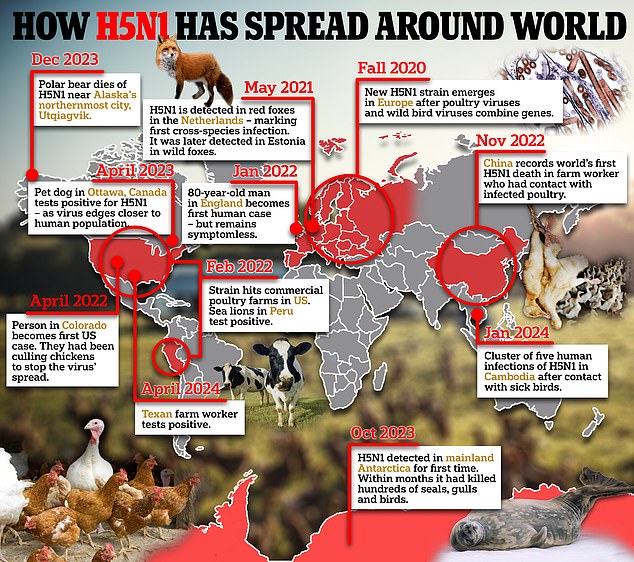Is YOUR state at risk of bird flu spillover? Map reveals epicenters for diseases sweeping through farms
Fifteen farms in six US states are experiencing outbreaks of bird flu – amid growing concerns that the virus could spread to humans.
Texas, Kansas, New Mexico, Michigan, Idaho and Ohio have all reported the virus in herds, raising concerns about milk supplies.
At the same time, America’s largest egg producer – in Texas – has also had to cull almost two million birds after the disease was discovered in its flock, which could drive up the price of eggs.
The first case in cattle was reported in Texas on March 25, after which cases were reported in herds across the country as cattle were shipped out of the state.
A farm worker in Texas has tested positive for the virus and three cats in the state have reportedly died from the disease.
Health authorities say the risk to the public is still low, but farm workers in close contact with infected animals and equipment are at greater risk.
The map above shows states where infections in cattle have been detected
Scientists are not sure how the virus spreads among livestock, but experts suggest it could happen through infected milk droplets on the clothing or gloves of dairy workers or on the suction cups of milking machines.
Tests have so far only picked up the virus in cow’s milk, while samples from the nose and blood of infected animals have proven negative.
“We haven’t seen any real indication that the cows are actively shedding virus and directly exposing it to other animals,” said Dr. The agency’s Mark Lyons during a briefing yesterday, reports Science.
It is believed that cats became infected after consuming infected milk from cows.
Texas – America’s largest cattle state – is hardest hit by the outbreaks, with seven farms reportedly having cows infected with bird flu.
Three farms in Kansas are also reporting infected cattle, as are two in New Mexico and one each in Michigan, Idaho and Ohio.
Many of these have been linked to Texas, having recently received livestock from infected farms in the state. It is not unusual at this time of year for dairy herds to be sent to more northern areas.
It is reported that sick cows currently eat less and produce less milk, although they do not die from the disease.
Experts worry about infections in mammals because each virus gives the virus an opportunity to acquire mutations, making it better able to infect mammals and spread between them.
Some have also raised concerns about the human infection, saying it is so mild there is a risk of missing other human cases.
Dr. Angela Rasmussen, a virologist at the University of Saskatchewan, said: ‘Of particular concern is the fact that this human case was limited to mild conjunctivitis.
‘That’s good for the person who got H5N1. But it is not good to prevent overflow. Mild cases may go unrecognized and isolated.”
Officials say they first became concerned that bird flu might have spread to livestock in mid-February, after dead domestic birds and cats were spotted on farms.
This led to cattle being tested for the virus, which ultimately revealed the virus.

The human case was also subsequently revealed after they came in for treatment for an eye infection.
The CDC says it is taking the bird flu case in the US “very seriously” amid growing fears that the virus could jump to humans and cause an epidemic.
Mandy Cohen, the agency’s director, told NPR that they were “monitoring the situation closely.”
She added: ‘That just means more opportunities for this virus to mutate and change. And that’s what we want to ensure we stay ahead of the curve.”
Experts are concerned about bird flu because of the apparent ease with which it infects a wide range of mammals – now found in more than 40 different species.
They worry that the more infections that occur in mammals, the greater the risk that the virus will acquire mutations that allow it to infect and spread between them.
